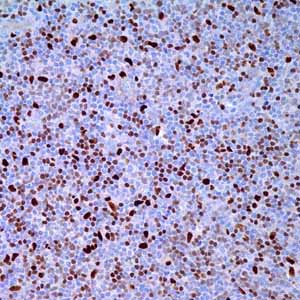
PU.1 (EPR3158Y)

PU.1 is a transcription factor that has been shown to be important for normal B-cell development. PU.1 belongs to the ETS family of transcription factors. It is expressed in the myeloid lineage and in immature as well as mature B-lymphocytes, with the exception of plasma cells. PU.1 is essential during early B-cell differentiation. The absence of PU.1 results in total block of B-cell development at the pre-pro stage. Very little is known about PU.1 function in later stages of B-cell development. PU.1 does not seem to play a role in the end-stage of B-cell development and is not expressed in plasma cells. PU.1 exerts an important role in the regulation of the expression of crucial B-cell proteins, such as immunoglobulin (Ig) genes, and CD20 and its putative binding sites were also identified in the promoters of CD79, CD10, and CD22. PU.1 binds to the 3’ enhancer region of both the Ig kappa and lambda light chain genes and it also regulates the immunoglobulin heavy chain genes through the intron enhancer region.1-2
PU.1 is expressed in germinal center B-cells and mantle B-cells. Various lymphomas are also positive for this marker including the following: B-chronic lymphocytic leukemia, mantle cell lymphoma, follicular lymphoma, marginal zone lymphoma, Burkitt lymphoma, diffuse large cell lymphoma, diffuse large B-cell lymphoma, T-cell rich B-cell lymphoma, and nodular lymphocyte predominant Hodgkin lymphoma.3
